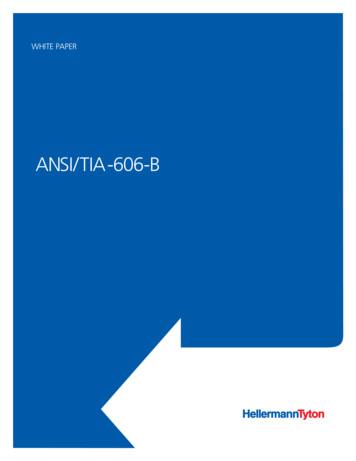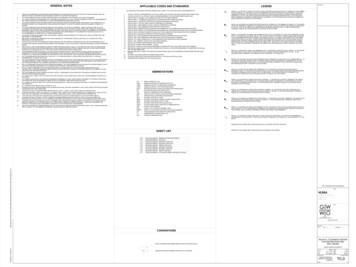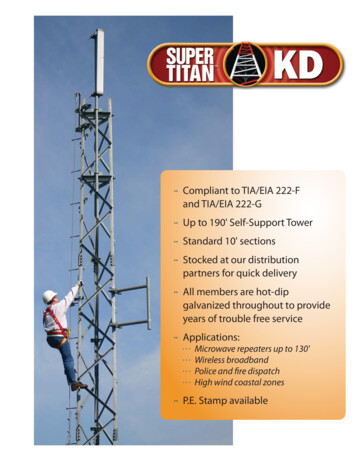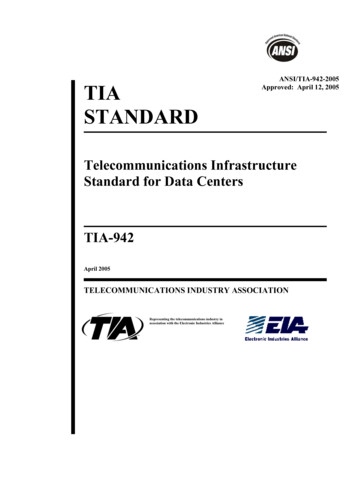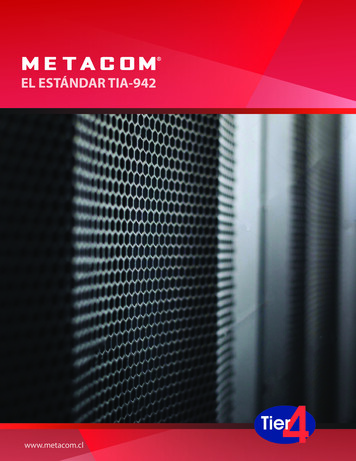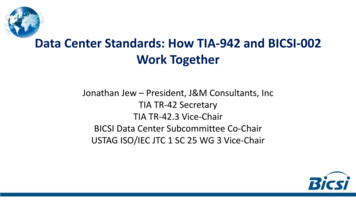
Transcription
Data Center Standards: How TIA-942 and BICSI-002Work TogetherJonathan Jew – President, J&M Consultants, IncTIA TR-42 SecretaryTIA TR-42.3 Vice-ChairBICSI Data Center Subcommittee Co-ChairUSTAG ISO/IEC JTC 1 SC 25 WG 3 Vice-Chair
Jonathan Jew30 years90 data center projectsCo-Chair BICSI Data Center Design & Implementation SubcommitteeUS Project Lead for ISO/IEC 24764 and ISO/IEC 11801-5 international datacenter cabling standards Primary contributor ANSI/TIA-942, ANSI/TIA-942-A, and editor of ANSI/TIA942-B revision (data centers) Primary contributor ISO/IEC TR 14763-2-1 telecom identifiers, ANSI/TIA606-B telecom administration, and editor ANSI/TIA-606-C revision
TIA-942 & BICSI-002 are each part of afamily of publications
TIA-942 is part of a family of TR-42 cabling IA-569-D(Pathways C(Administration)ANSI/TIA-607-C(Bonding andgrounding[earthing])ANSI/TIA-758-B(Outside plant)ANSI/TIA-862-B(Intelligent BuildingSystems)ANSI/TIA-942-B(Data d twistedpair)ANSI/TIA-568.3-D(Optical ealthcare)ANSI/TIA-4966(Educational)Not Assigned(Large Buildings –Places of Assembly)ANSI/TIA-568.4-D(Broadbandcoaxial)
TIA standards apply in US and Canadaand are widely used in other countries
Other families of standards apply inother countries
European (CENELEC) premises cabling standardsCommonStandardsPremisesStandardsEN 50173-1Generic cablingrequirementsEN 50173-2Office PremisesEN 50174-1Specification &Quality AssuranceEN 50173-3Industrial PremisesEN 50174-2Installation planning& practices insidebuildingsEN 50174-3Installation planning& practices outsidebuildingsEN 50310Equipotentialbonding & earthingEN 50346Testing of installedcablingEN 50173-4HomesEN 50173-5Data Centres
International (ISO/IEC) premises cabling standardsCommonStandardsPremisesStandardsISO/IEC 11801-1Generic cablingrequirementsISO/IEC 11801(ISO/IEC 11801-2in next revision)Office premisesISO/IEC 14763-2Planning &InstallationISO/IEC 14763-3Testing of OpticalFiber CablingISO/IEC 18598AutomatedInfrastructure MgmtISO/IEC 30129Telecom BondingISO/IEC 11801-6Distributed BuildingServicesISO/IEC 24702(ISO/IEC 11801-3in next revision)Industrial PremisesISO/IEC 15018(ISO/IEC 11801-4in next revision)HomesISO/IEC 24764(ISO/IEC 11801-5in next revision)Data CentresTechnicalReportsISO/IEC TR 24704Wireless accesspoint cablingISO/IEC TR 24750Support of10GBaseTISO/IEC 29106MICE classificationISO/IEC 29125Remote poweringISO/IEC TR 1180199-1Cabling for 40G
BICSI standards and manuals are also afamily of complementary publicationsand are meant to work with TIA,CENELEC, ISO, & other national standards
BICSI-002 is part of a family of standards & 05Electronic Security& SafetyBICSI-006Distributed AntennaSystems (DAS)BICSI-607GroundingBICSI-007Intelligent BuildingSystemsBICSI-008Wireless LANsNew OSPInstallationNewCabling InstallationNewPoE InstallationPracticesBICSI-002Data CentersBICSI-004HealthcareBICSI-009Data ibution MethodsManualOSPDRMOutside Plant DesignReference ManualITSIMMInformationTechnology SystemsInstallation MethodsManualTPMMTelecommunicationsProject ManagementManual
BICSI Publications Complement National StandardsBICSI BestPractices(e.g., TDMM,BICSI-002)Codes(e.g., NFPA 70NEC)NationalStandardsCENELEC forEuropeCompanyStandardsNationalStandardsTIA for US &CanadaNationalStandardsISO/IEC formany otherExample: BICSI-002specifies to see nationalstandard for mesh-bondingnetwork design,temperature & humiditylimits, telecom cablingdesign
BICSI-002 by design is intended tocomplement TIA-942 and othernational data center standards, and isincomplete without them
TIA-942 and BICSI-002 TIA-942 provides requirements for the design ofdata center telecommunications infrastructure BICSI-002 provides a wide range of information,recommendations, and requirements regarding allaspects of designing a data center
TIA-942 and BICSI-002 BICSI-002 provides best practices that exceed theminimum requirements of TIA-942 BICSI-002 provides information on a wide range ofsubjects not covered in TIA-942
BICSI-002 Best Practices vs TIA-942 requirements Example: Ceiling heights– TIA-942 minimum height 2.6 m (8.5 ft)– BICSI-002 minimum height 3 m (10 ft) Recommended height 4.5 m (15 ft) or greater
BICSI-002 provides information on a wide range of subjects not covered in TIA-942114 PagesPages503 Pages
nicalSpace ySite SelectionArchitecturalFire ProtectionDCIM & BASDesign ProcessStructuralOutsourcingMultiple Data CentersEnergy EfficiencyTOTALBICSI-002 mostly deals with aspects of dataPagescenter design other than telecom1208444403229282523201610884444503
Using BICSI-002 & TIA-942 Design of the telecommunications cablinginfrastructure (cabling system, pathways, spaces)should use both TIA-942-B and BICSI-002-2014 Use BICSI-002 to understand other aspects of thedata center design and make informed decisionswhen specifying requirements and reviewingdesigns by other disciplines
DC Operations Standard New BICSI 009 Data Center Operations standard beingdeveloped Includes participants from a wide variety oforganizations & countries Use as a reference for operation & maintenance of thedata center after it is built
DC Operations Standard Sections GovernanceStandard Operating ProceduresMaintenance ProceduresEmergency Operating ProceduresManagement
ANSI/TIA-942 TelecommunicationsInfrastructure for Data Centers
ANSI/TIA-942 Background ANSI/TIA-942, originally published in April 2005, was the first standarddeveloped by an accredited standards organization that specifically addressedphysical data center infrastructure TIA-942 was developed by experts mostly from the US and Canada, but it alsoincluded experts from other countries Contributions from many organizations in the data center industry thatnormally don’t participate in TIA standards Continuously updated to accommodate changes in technologies and practices
What is In TIA-942? Cabling scheme topology – hierarchical tree with elements added forredundancy Types of cabling (balanced twisted-pair, multimode fiber, singlemode fiber, T3/E3 coaxial cable, broadband coaxial cable) Cable lengths (dependent on media & applications) Telecommunications pathways – cable trays, conduit, optical fiberduct, etc. Cabling system distributors (main, intermediate, horizontal)
What is In TIA-942? Requirements for computer rooms and entrance rooms (e.g., doorsizes, lighting, temperature, humidity, floor loading) Supporting circuits (T3, E3, T1, E1, TIA-232 & TIA-561 serialconsole, and data center fabrics) Energy efficiency considerations Access providers (demarcation, information to provide to carriers,information that carriers should provide to data center designer) Site selection considerations
What is In TIA-942? Informative Annex on Rating of data center availability (similar toTiers and BICSI Classes)– Telecommunications Infrastructure– Architectural– Security– Structural– Electrical– Mechanical
TIA-942 Revisions and Addenda ANSI/TIA-942 Addendum 1 - Data Center Coaxial Cabling Specifications andApplication Distances, March 2008, ANSI/TIA-942 Addendum 2 - Additional Guidelines for Data Centers,February 2010, Harmonized with 2008 ASHRAE Environmental Guidelinesfor Datacom Equipment and several other updates ANSI/TIA-942-A - Aug 2012 - Major modification to TIA-942 to incorporatenew technologies and data center practices ANSI/TIA-942-B – June 2017- additional updates to incorporate newtechnologies and practices
Updates in TIA-942-B Added MPO-16 and MPO-32 (ANSI/TIA-604-18) and MPO-24 (ANSI/TIA-604-5) asoptions for termination of more than two fibers in addition to the MPO-12connector Added category 8 as an allowed type of balanced twisted-pair cable. Changedrecommendation for category 6A balanced twisted-pair cable to category 6A orhigher Added OM5 wideband laser-optimized 50/125 um multimode as an allowed andrecommended type of multimode fiber cable Added 75-ohm broadband coaxial cables and connectors as specified in ANSI/TIA568.4-D as allowed types of coaxial cables and connectors
12 & 32-fiber MPOs12-fiber MPO has 4 of 12unused fibers for 40G and 100G400GBASE-SR16 (400G Ethernet) will use32-fiber MPO and waste no OM3/OM4 fibers
Category 8 Balanced Twisted-Pair 24 m max permanent link (panel-to-panel) 30 to 32 m channels (3 to 4 m patch cords depending on deratingfactor of cords) No intermediate patch panels
OM5 Wideband multimode fiber OM5 or wideband multimode fiber recently approved in June 2016 asANSI/TIA-492AAAE. OM5 name was approved by ISO/IEC in Oct 2016 Supports 4 wavelengths in a single-pair of fibers allowing 40G or 100GEthernet, which currently require 4-pairs of fibers, to run on a single pair TIA recently approved lime green as the color for OM5 jackets, connectors,and adapters
Updates in TIA-942-B Added recommendation to not install optical fiber cords and cables (both bendinsensitive and non-bend insensitive) without adequate armoring or sufficiently thickjacket in pathways that can create microbends, such as non-continuous cable supports,wire basket trays, and cable ladders without radiused cable supports or solid bottoms.
Updates in TIA-942-B Reduced quantity of convenience outlets required on computer roomwalls (to one per wall minimum from previous minimum spacing of 12ft apart) Local fire protection codes may be used instead of NFPA 75 Power for air conditioning systems and controls in computer roomsand entrance rooms should be redundant, but do not need to bepowered from the same PDUs or panel boards that serve ICTequipment in the room Added recommendation that cabinets be at 1200 mm (48”) deep andto consider cabinets wider than 600 mm (24”) wide.
Updates in TIA-942-B Recommended maximum cable lengths for direct attach cabling in equipment distributionareas or EDAs (e.g., server cabinets) has been reduced from 10 m (33 ft) to 7 m (23 ft),adequate from top-of-rack switch to servers in same or adjacent cabinet7m maximum cable length doesn’t apply to cabling within distributors (MDA, IDA, HDA,Entrance Room), however direct attach cabling within distributors should be within a row.
Updates in TIA-942-B Added recommendation to consider preterminated cabling to reduce installationtime and improve consistency and quality of terminations.
Updates in TIA-942-B Added recommendation to consider needs for proper labeling, cable routing,cable management, and ability to insert and remove cords without disruptingexisting or adjacent connections when selecting patch panels.
Updates in TIA-942-B Adds normative reference to ANSI/TIA-5017 regarding physical security for the datacenter telecommunications infrastructure published Feb 2016 Of interest to any designer concerned about enhanced physical security fortelecommunications pathways & spaces Participants included persons involved in designing telecommunications infrastructurefor classified military facilities, but information is useful to anyone concerned aboutphysical security
Updates in TIA-942-B Adds normative reference to ANSI/TIA-862-B for cabling for intelligentbuilding systems including networked data center electrical, mechanical, andsecurity equipment (published Feb 2016) Provides guidelines for cabling of a wide range of intelligent building systemsused in all types of buildings, especially in data centers (e.g., security,electrical, HVAC, energy management, lighting systems, wireless)
Updates in TIA-942-B Added reference to TIA TSB 162-A for guidelines regarding cabling for wireless accesspoints (published Nov 2013) Added reference to TIA TSB-5018 for guidelines regarding cabling for DAS (distributedantenna systems) published July 2016 Added reference to TIA TSB-184-A for guidelines regarding power delivery overbalanced twisted-pair cabling (published Mar 2017), which was updated to includehigher power levels (1000 mA per pair) and refined temperature rise models Numerous changes to the rating tables in Annex F including those that specifyconcurrent maintainability for Rating-3 (formerly Tier 3) and fault tolerance for Rating4 (formerly Tier 4).
Updates in Referenced TIA-569-D Standard Incorporated revised temperature and humidity limits from ASHRAE ThermalGuidelines, 4th edition (which permits a wider range of temperature &humidity to reduce energy consumption) Changed maximum 2.1 m (7 ft) maximum cabinet/rack height from arequirement to a recommendation permitting use of taller cabinets/racks
Updates in Referenced TIA-569-D Standard Reduced minimum distance between top of cable tray and obstructionsor cable tray above from 300 mm (12 in) to 200 mm (8 in) – impactsrequired ceiling heights or raised floor heights for stacked cable trays24"24"RAISED FLOOR TILE1.375"RAISED FLOOR TILE2"8"4"FIBER1"1.375"2"6"6"8"4"FIBERSUPPORT STRUTSUPPORT STRUT1"4"Main aisle fiber tray12"36"12"18"18"COPPER CABLING1"12" min clearancebetween trays6"6"SUPPORT STRUTCOPPER CABLINGSUPPORT STRUTMain aisle copper trayHOT AISLEServer Row10.625"4.625"HOT AISLEServer Row1"6"
Updates in Referenced TIA-607-C Standard Electrically continuous structural metal frame of thebuilding may be used in place of a TBB(telecommunications bonding backbone)
Questions?Jonathan Jew - President J&M Consultants, Inc.Website: www.j-and-m.comEmail: jew@j-and-m.comCo-chair BICSI data center subcommitteeEditor TDMM 13th Edition Telecom AdministrationVice-Chair TIA TR-42.3 pathways & spacesVice-Chair USTAG to ISO/IEC JTC 1 SC 25 WG 3Editor ISO/IEC TR 14763-2-1 telecom admin identifiersSME BICSI TI&M Telecommunications AdministrationSecretary TIA TR-42
Data Center Standards: How TIA-942 and BICSI-002 Work Together Jonathan Jew - President, J&M Consultants, Inc TIA TR-42 Secretary. . US Project Lead for ISO/IEC 24764 and ISO/IEC 118015 international data - center cabling standards Primary contributor ANSI/TIA-942, ANSI/TIA-942-A, and editor of ANSI/TIA-942-B revision (data centers)
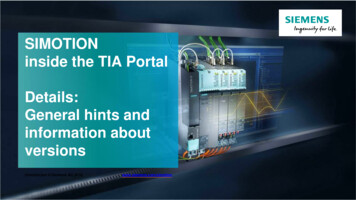
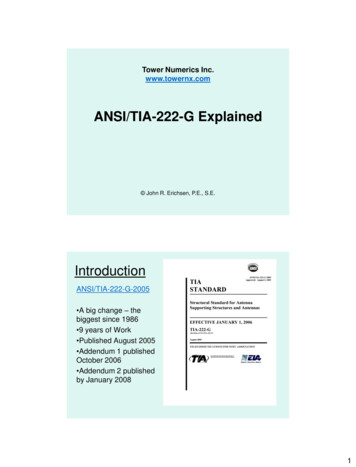
![[VERIFIED] Siemens Tia Portal V11 Crack 49 8](/img/66/olwder.jpg)
